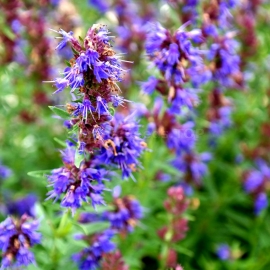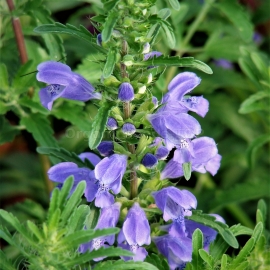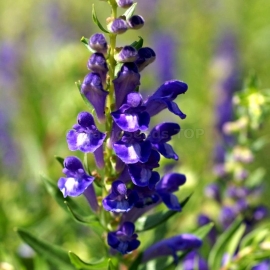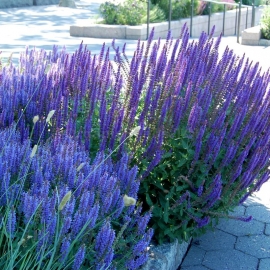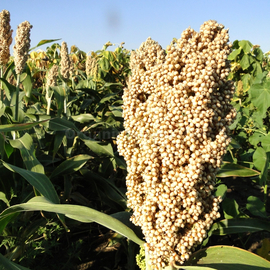


«White African» - Organic Sorghum Seeds
1.14 €
An annual or perennial cereal plant. Refers to spring crops. Its homeland is considered to be the regions of East Africa, where the plant began to be grown in the 4th century BC. e.
-
Sorghum «White African»
Annual or perennial cereal plant. Refers to spring crops. Its homeland is considered to be the regions of East Africa, where the plant began to be grown in the 4th century BC. e. Culture is in fifth place in terms of global production.
Such a high popularity of sorghum is explained by the fact that the plant is unpretentious in care, produces a large harvest and has many useful properties that can be used in various fields of industry. It is very advantageous that growing the crop does not require special machinery and equipment.
Sorghum is a very heat-loving plant. For its normal development and productivity, a temperature of 25-30 °C must prevail during growth. Frosts can lead to the death of the crop. At the same time, sorghum is very resistant to droughts, various pests and diseases. Has a well-developed root system.
Undemanding to the composition of the soil, it grows on both loamy and sandy, clayey rocks. It needs regular treatment against weeds, and in conditions of development on infertile land, it also needs additional fertilizer. The plant is very rich in useful substances and vitamin complex.
Agricultural technology:
Good precursors for sorghum are annual legumes, as well as winter grains and row crops.
Soil cultivation. Soil cultivation for sorghum usually begins in the fall: after grain harvesting, stubble peeling, deep autumn plowing are carried out, and in the spring - early spring harrowing in 2-3 traces, cultivation and before sowing cultivation with harrowing; in the conditions of the southeast - deep fall plowing in the fall.
Sowing or planting. Sorghum is sown late, when the soil temperature at a depth of 10 cm reaches +10...12oC. For hay and green fodder, sorghum is sown in a continuous row with row spacing of 30-45 cm. The seeding rate is 20-30 kg of seeds per 1 ha. For grain, as well as for technical purposes, this crop is sown in wide rows, with row spacing of 70 cm. The seed sowing rate for grain is 10-15 kg per 1 ha. Seeds are planted to a depth of 3-5 cm, on dry and loose soils up to 7 cm.
Care. After sowing, if a soil crust forms, it is destroyed by harrowing across the rows. For wide-row crops, inter-row cultivation is carried out.
Fertilizers. Organic and mineral fertilizers significantly increase the yield of sorghum. Manure, potassium and phosphorus fertilizers are applied in the fall under fall plowing, nitrogen fertilizers are applied in the spring and covered with a harrow or cultivator. Good results are obtained from applying granular fertilizers at the same time as the seeds.
It is advisable to feed the plants with fertilizers after the first mowing; the yield of the second and third cuttings increases significantly. Fertilizing sorghum is especially effective on sandy and washed-out soils.
Cleaning. Sorghum for grain is harvested in the phase of full ripeness using combines or, in extreme cases, simple machines, followed by cutting off the heads. Sorghum is harvested for hay and green fodder at the beginning of panicle formation. With later harvesting, the forage mass becomes coarser, and the yield of the second mowing is reduced. Sorghum is cut for silage in the phase of waxy ripeness of the grain. Broom sorghum is harvested in two stages: first, the panicles are cut off, and then the rest of the mass is cut off with a hay mower.
With this product buy
Product code: 4467
1.14 €
Many herb gardeners are growing Hyssop seeds in their gardens. This hardy perennial likes full sun and well-drained, alkaline soil. It is a bushy plant with woody stems and small leaves. Pollinators love Hyssop flowers!
Product code: 6776
1.14 €
An annual herb with a thin taproot and an erect tetrahedral, branched stem 40-60 cm high.
Product code: 11898
1.14 €
The herb garden has never had a more lovely perennial that can be grown from herb seeds! Skullcap is an attractive ornamental herb with erect stems of bluish-purple blooms that arrive in the latter part of spring.
Product code: 12549
1.14 €
A shimmering ocean of blue purple flowers awaits all those who plant this impressive plant in their garden. This plant is commonly known as Meadow Sage and is a pollinator plant! Beautiful bright blue, almost purple flowers spike off of a long green stem.

